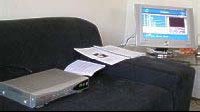Once set only minor adjustment is necessary as the Campersat is moved around Australia.
 Read off Elevation (Tilt) = In Melbourne 44deg. Sydney is 50 deg. It is a ‘right hand thread’ but, the Campersat elevation marker can be set up for left-handers. Now get the test meter on the back of the dish backbone buzzing by pressing the two yellow buttons on its face simultaneously. You get a visual read out too in red bars. Read off Direction (Azimuth) = InMelbourne 17deg to the right (east) of north. Rotate the Dish to get the maximum signal from the test meter. Lightly lock the Dish and press Channel 1OK on the Campersat remote.
Read off Elevation (Tilt) = In Melbourne 44deg. Sydney is 50 deg. It is a ‘right hand thread’ but, the Campersat elevation marker can be set up for left-handers. Now get the test meter on the back of the dish backbone buzzing by pressing the two yellow buttons on its face simultaneously. You get a visual read out too in red bars. Read off Direction (Azimuth) = InMelbourne 17deg to the right (east) of north. Rotate the Dish to get the maximum signal from the test meter. Lightly lock the Dish and press Channel 1OK on the Campersat remote.There on the TV screen will be information about the C1 Satellite and Optus matters. Maximum signal strength helps reception in heavy rain. Normal rainfall will not affect the system, but reception on the high frequency Kuband can be effected by excessively heavy rain. But this only happens if the rain is directly in the path of the satellite beam. We used the Campersat through days of normal rain with no apparent reception issues.
 The Test Meter reads relative signal and both elevation and azimuth must be trimmed to peakthe satellite signal. Pressing the two yellow buttons on the meter turns the tone on and off. There are two scales; the bottom scale is tens and the top scale units. If the Test meter runs full scale, press the left button to reduce meter sensitivity. This helps with reading maximums. Once set on maximum this can only be reversed by disconnecting and reconnecting the signal cable. If you lock onto a satellite other than C1, the same sharp peak signal will come from the Test Meter, but the Receiver willreport ('E48 Search for signal,').
The Test Meter reads relative signal and both elevation and azimuth must be trimmed to peakthe satellite signal. Pressing the two yellow buttons on the meter turns the tone on and off. There are two scales; the bottom scale is tens and the top scale units. If the Test meter runs full scale, press the left button to reduce meter sensitivity. This helps with reading maximums. Once set on maximum this can only be reversed by disconnecting and reconnecting the signal cable. If you lock onto a satellite other than C1, the same sharp peak signal will come from the Test Meter, but the Receiver willreport ('E48 Search for signal,').There are three satellites close to C1. Satellite PAS8 is very strong Australia wide and only 20 deg east ofC1. C1 is at its maximum strength along the east coast from Adelaide to Rockhampton. Also close to C1 are B3, close to the west and B1, just east of C1. The Test Meter will respond to all satellites, but theCampersat Receiver will only load C1 and B3.If C1 is not found tilt the Dish up or down one degree until C1 loads on the TV screen on Optus Aurora Tuning Channel 1. Be patient, take your time and it will happen.
If you can see the TV screen and the Receiver while you are making adjustments to the dish you will see the Campersat Receiver lock and load when you score bulls-eye lighting up the Channel Lock Indicator in its face a happy green.
 Satellite B3 can be targeted in the same way for international bordmulti-lingual/religious programs. B3 is about one degree higher in elevation (tilt) than C1 and about 10 deg to the west. Follow the Reloading satellite services menu in the Receiver’s manual and change the satellite to OptusB3_Ku. The receiver downloads the B3 information and 'stacks' the B3 channels after the C1 channels. To change satellites, re-point the Campersat Dish, press the SAT button on the Campersat remote and select the satellite at which the Dish is pointing.
Satellite B3 can be targeted in the same way for international bordmulti-lingual/religious programs. B3 is about one degree higher in elevation (tilt) than C1 and about 10 deg to the west. Follow the Reloading satellite services menu in the Receiver’s manual and change the satellite to OptusB3_Ku. The receiver downloads the B3 information and 'stacks' the B3 channels after the C1 channels. To change satellites, re-point the Campersat Dish, press the SAT button on the Campersat remote and select the satellite at which the Dish is pointing.If the Smart Card, which is preloaded in the Campersat Receiver, is a little behind the Optus satellite updates, open Channel 1. It does not need the Smart Card. Press OK on the Campersat remote and let it run. System updates will download from the satellite for an hour or two. Then 'normal programs are available'.

No comments:
Post a Comment